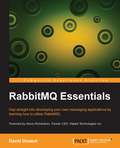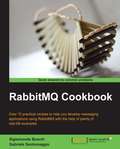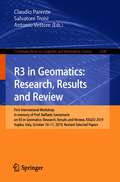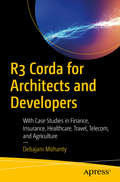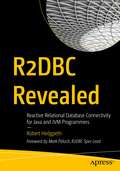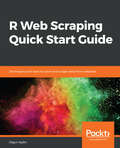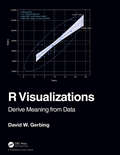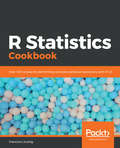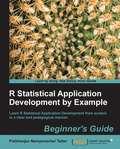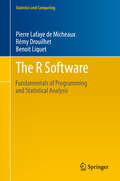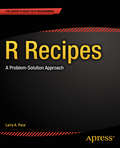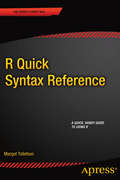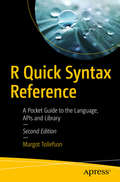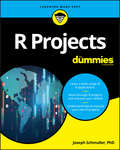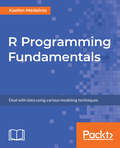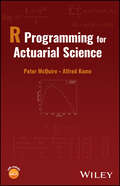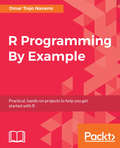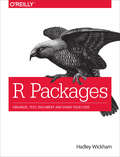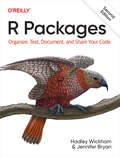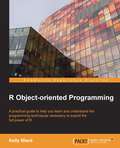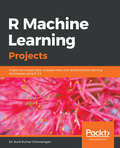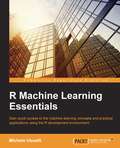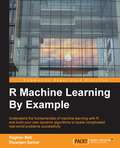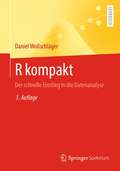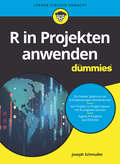- Table View
- List View
RabbitMQ Essentials
by David DossotThis book is a quick and concise introduction to RabbitMQ. Follow the unique case study of Clever Coney Media as they progressively discover how to fully utilize RabbitMQ, containing clever examples and detailed explanations. Whether you are someone who develops enterprise messaging products professionally or a hobbyist who is already familiar with open source Message Queuing software and you are looking for a new challenge, then this is the book for you. Although you should be familiar with Java, Ruby, and Python to get the most out of the examples, RabbitMQ Essentials will give you the push you need to get started that no other RabbitMQ tutorial can provide you with.
RabbitMQ Cookbook
by Sigismondo Boschi Gabriele SantomaggioA practical book filled with advanced recipes as well as plenty of code and real-life examples which will make your learning curve quick and easy.If you are a software developer who wants to develop distributed applications based on messaging, then this book is for you. It's assumed that you have some experience with multithreading applications and distributed applications. You are also expected to know the basic concepts of Web and cloud applications in order to follow the recipes effectively.
R3 in Geomatics: First International Workshop in memory of Prof. Raffaele Santamaria on R3 in Geomatics: Research, Results and Review, R3GEO 2019, Naples, Italy, October 10–11, 2019, Revised Selected Papers (Communications in Computer and Information Science #1246)
by Claudio Parente Salvatore Troisi Antonio VettoreThis book constitutes the refereed proceedings of the First International Workshop in memory of Prof. Raffaele Santamaria on R3 in Geomatics: Research, Results and Review, R3GEO 2019, held in Naples, Italy*, in October 2019.The 27 full papers along with the 2 short papers presented were carefully reviewed and selected from 39 submissions. The papers are organized in topical sections on: GNSS and geodesy; photogrammetry and laser scanning; GIS and remote sensing.
R3 Corda for Architects and Developers: With Case Studies in Finance, Insurance, Healthcare, Travel, Telecom, and Agriculture
by Debajani MohantyExplore the entire R3 Corda ecosystem using theory, labs, and use cases. This book introduces distributed ledger technology, Corda architecture, and smart contract programming in Java, guiding you through testing and deployment. Further, you will explore various business problems in finance, insurance, healthcare, travel, and agriculture and discover how Corda can solve these issues through its unique and efficient distributed ledger technology. These business scenarios come with flowcharts, diagrams, and sample code that stakeholders can refer to and further enhance during live projects. After reading R3 Corda for Architects and Developers, you will understand how efficient usage of Corda can create value for your business processes by making business intelligence more readily available, user friendly, and interactive. What You Will Learn Work with distributed ledger technologyDiscover Corda’s differentiators Develop smart contracts, states, and business flows on Corda Take advantage of Corda in your business by going through case studies in various domains Who This Book Is For Blockchain developers and architects who wish to learn Corda.
R2DBC Revealed: Reactive Relational Database Connectivity for Java and JVM Programmers
by Robert HedgpethUnderstand the newest trend in database programming for developers working in Java, Kotlin, Clojure, and other JVM-based languages. This book introduces Reactive Relational Database Connectivity (R2DBC), a modern way of connecting to and querying relational databases from Java and other JVM languages. The book begins by helping you understand not only what reactive programming is, but why it is necessary. Then building on those fundamentals, the book takes you into the world of databases and the newly released Reactive Relational Database Connectivity (R2DBC) specification. Examples in the book are worked using the freely available MariaDB database along with MariaDB’s vendor-implementation of the R2DBC service-provider interface (SPI). Following along with the examples and the provided example code helps prepare you to work with any of the growing number of R2DBC implementations for popular enterprise databases such as Oracle Database and SQL Server. You’ll be well prepared for what is becoming the future of database access from Java and other languages built on the JVM.What You Will LearnUnderstand why R2DBC was created and how it utilizes the Reactive Streams API Understand the components of the R2DBC service-provider interfaceCreate and manage reactive database connections and connection pools using an R2DBC clientProgrammatically execute queries on a relational database using an R2DBC clientEffectively utilize transactions using an R2DBC clientBuild relational database-driven applications that are event-driven and non-blockingWho This Book Is ForSoftware developers building solutions using JVM languages and the JVM ecosystem, and developers who need an introduction to the R2DBC specification and reactive programming with relational databases and want to understand what Reactive Relational Database Connectivity is and why it came about. This book includes practical examples of using the R2DBC specification with Java and MariaDB that will provide developers with the knowledge they need to create their own solutions.
R Web Scraping Quick Start Guide: Techniques and tools to crawl and scrape data from websites
by Olgun AydinWeb Scraping techniques are getting more popular, since data is as valuable as oil in 21st century. Through this book get some key knowledge about using XPath, regEX; web scraping libraries for R like rvest and RSelenium technologies. Key FeaturesTechniques, tools and frameworks for web scraping with RScrape data effortlessly from a variety of websites Learn how to selectively choose the data to scrape, and build your datasetBook DescriptionWeb scraping is a technique to extract data from websites. It simulates the behavior of a website user to turn the website itself into a web service to retrieve or introduce new data. This book gives you all you need to get started with scraping web pages using R programming.You will learn about the rules of RegEx and Xpath, key components for scraping website data. We will show you web scraping techniques, methodologies, and frameworks. With this book's guidance, you will become comfortable with the tools to write and test RegEx and XPath rules. We will focus on examples of dynamic websites for scraping data and how to implement the techniques learned. You will learn how to collect URLs and then create XPath rules for your first web scraping script using rvest library. From the data you collect, you will be able to calculate the statistics and create R plots to visualize them. Finally, you will discover how to use Selenium drivers with R for more sophisticated scraping. You will create AWS instances and use R to connect a PostgreSQL database hosted on AWS. By the end of the book, you will be sufficiently confident to create end-to-end web scraping systems using R.What you will learnWrite and create regEX rulesWrite XPath rules to query your dataLearn how web scraping methods workUse rvest to crawl web pagesStore data retrieved from the webLearn the key uses of Rselenium to scrape dataWho this book is forThis book is for R programmers who want to get started quickly with web scraping, as well as data analysts who want to learn scraping using R. Basic knowledge of R is all you need to get started with this book.
R Visualizations: Derive Meaning from Data
by David GerbingR Visualizations: Derive Meaning from Data focuses on one of the two major topics of data analytics: data visualization, a.k.a., computer graphics. In the book, major R systems for visualization are discussed, organized by topic and not by system. Anyone doing data analysis will be shown how to use R to generate any of the basic visualizations with the R visualization systems. Further, this book introduces the author’s lessR system, which always can accomplish a visualization with less coding than the use of other systems, sometimes dramatically so, and also provides accompanying statistical analyses. Key Features Presents thorough coverage of the leading R visualization system, ggplot2. Gives specific guidance on using base R graphics to attain visualizations of the same quality as those provided by ggplot2. Shows how to create a wide range of data visualizations: distributions of categorical and continuous variables, many types of scatterplots including with a third variable, time series, and maps. Inclusion of the various approaches to R graphics organized by topic instead of by system. Presents the recent work on interactive visualization in R. David W. Gerbing received his PhD from Michigan State University in 1979 in quantitative analysis, and currently is a professor of quantitative analysis in the School of Business at Portland State University. He has published extensively in the social and behavioral sciences with a focus on quantitative methods. His lessR package has been in development since 2009.
R Statistics Cookbook: Over 100 recipes for performing complex statistical operations with R 3.5
by Francisco JuretigSolve real-world statistical problems using the most popular R packages and techniques Key Features Learn how to apply statistical methods to your everyday research with handy recipes Foster your analytical skills and interpret research across industries and business verticals Perform t-tests, chi-squared tests, and regression analysis using modern statistical techniques Book Description R is a popular programming language for developing statistical software. This book will be a useful guide to solving common and not-so-common challenges in statistics. With this book, you'll be equipped to confidently perform essential statistical procedures across your organization with the help of cutting-edge statistical tools. You'll start by implementing data modeling, data analysis, and machine learning to solve real-world problems. You'll then understand how to work with nonparametric methods, mixed effects models, and hidden Markov models. This book contains recipes that will guide you in performing univariate and multivariate hypothesis tests, several regression techniques, and using robust techniques to minimize the impact of outliers in data.You'll also learn how to use the caret package for performing machine learning in R. Furthermore, this book will help you understand how to interpret charts and plots to get insights for better decision making. By the end of this book, you will be able to apply your skills to statistical computations using R 3.5. You will also become well-versed with a wide array of statistical techniques in R that are extensively used in the data science industry. What you will learn Become well versed with recipes that will help you interpret plots with R Formulate advanced statistical models in R to understand its concepts Perform Bayesian regression to predict models and input missing data Use time series analysis for modelling and forecasting temporal data Implement a range of regression techniques for efficient data modelling Get to grips with robust statistics and hidden Markov models Explore ANOVA (Analysis of Variance) and perform hypothesis testing Who this book is for If you are a quantitative researcher, statistician, data analyst, or data scientist looking to tackle various challenges in statistics, this book is what you need! Proficiency in R programming and basic knowledge of linear algebra is necessary to follow along the recipes covered in this book.
R Statistical Application Development by Example Beginner's Guide
by Prabhanjan Narayanachar TattarFull of screenshots and examples, this Beginner's Guide by Example will teach you practically everything you need to know about R statistical application development from scratch. You will begin learning the first concepts of statistics in R which is vital in this fast paced era and it is also a bargain as you do not need to do a preliminary course on the subject.
The R Software
by Pierre Lafaye de Micheaux Rémy Drouilhet Benoit LiquetThe contents of The R Software are presented so as to be both comprehensive and easy for the reader to use. Besides its application as a self-learning text, this book can support lectures on R at any level from beginner to advanced. This book can serve as a textbook on R for beginners as well as more advanced users, working on Windows, MacOs or Linux OSes. The first part of the book deals with the heart of the R language and its fundamental concepts, including data organization, import and export, various manipulations, documentation, plots, programming and maintenance. The last chapter in this part deals with oriented object programming as well as interfacing R with C/C++ or Fortran, and contains a section on debugging techniques. This is followed by the second part of the book, which provides detailed explanations on how to perform many standard statistical analyses, mainly in the Biostatistics field. Topics from mathematical and statistical settings that are included are matrix operations, integration, optimization, descriptive statistics, simulations, confidence intervals and hypothesis testing, simple and multiple linear regression, and analysis of variance. Each statistical chapter in the second part relies on one or more real biomedical data sets, kindly made available by the Bordeaux School of Public Health (Institut de Santé Publique, d'Épidémiologie et de Développement - ISPED) and described at the beginning of the book. Each chapter ends with an assessment section: memorandum of most important terms, followed by a section of theoretical exercises (to be done on paper), which can be used as questions for a test. Moreover, worksheets enable the reader to check his new abilities in R. Solutions to all exercises and worksheets are included in this book.
R Recipes
by Larry A. PaceR Recipes is your handy problem-solution reference for learning and using the popular R programming language for statistics and other numerical analysis. Packed with hundreds of code and visual recipes, this book helps you to quickly learn the fundamentals and explore the frontiers of programming, analyzing and using R. R Recipes provides textual and visual recipes for easy and productive templates for use and re-use in your day-to-day R programming and data analysis practice. Whether you're in finance, cloud computing, big or small data analytics, or other applied computational and data science - R Recipes should be a staple for your code reference library.
R Quick Syntax Reference
by Margot TollefsonTheR Quick Syntax Referenceis a handy reference book detailing the intricacies of the R language. Not only is R a free, open-source tool, R is powerful, flexible, and has state of the art statistical techniques available. With the many details which must be correct when using any language, however, the R Quick Syntax Reference makes using R easier. Starting with the basic structure of R, the book takes you on a journey through the terminology used in R and the syntax required to make R work. You will find looking up the correct form for an expression quick and easy. With a copy of the R Quick Syntax Reference in hand, you will find that are able to use the multitude of functions availableto the R user and are even able to write your own functions to explore and analyze data. Takes you through learning R, from download to statistical analysis. Clears the confusion around object types and how to use and convert the types. Tells you how to search for statistical techniques using the R help pages. What you'll learn Download R and R packages for your platform. Work with R within your file structure. Enter data from the keyboard and from external files. Determine and assign modes, classes, and types of objects Do calculations using the computational tools in R. Use R functions and create new functions. Who this book is for TheR Quick Syntax Referenceis for statisticians and other data analysts who are starting to use the R language. It is also for veteran R users who want a quick reference to the language. The book is an excellent choice for the busy data scientist who likes to experiment with new ways of analysis and who needs the flexibility of the data editing available in R. Table of Contents Downloading R and Setting R Up in a File SystemThe R PromptAssignments and OperatorsModes of ObjectsThe Classes and TypesPackaged FunctionsUser Defined FunctionsHow to Use a Function Inputting or Creating Data Outputting Data and Output Manipulating Objects Flow Conditioners Condition Based Functions Some Examples of Conditioning Some Common Functions The Packages base, stats, and graphics Tricks of the Trade"
R Quick Syntax Reference: A Pocket Guide to the Language, APIs and Library
by Margot TollefsonThis handy reference book detailing the intricacies of R updates the popular first edition by adding R version 3.4 and 3.5 features. Starting with the basic structure of R, the book takes you on a journey through the terminology used in R and the syntax required to make R work. You will find looking up the correct form for an expression quick and easy. Some of the new material includes information on RStudio, S4 syntax, working with character strings, and an example using the Twitter API.With a copy of the R Quick Syntax Reference in hand, you will find that you are able to use the multitude of functions available in R and are even able to write your own functions to explore and analyze data.What You Will LearnDiscover the modes and classes of R objects and how to use themUse both packaged and user-created functions in R Import/export data and create new data objects in RCreate descriptive functions and manipulate objects in RTake advantage of flow control and conditional statementsWork with packages such as base, stats, and graphicsWho This Book Is ForThose with programming experience, either new to R, or those with at least some exposure to R but who are new to the latest version.
R Projects For Dummies
by Joseph SchmullerMake the most of R’s extensive toolset R Projects For Dummies offers a unique learn-by-doing approach. You will increase the depth and breadth of your R skillset by completing a wide variety of projects. By using R’s graphics, interactive, and machine learning tools, you’ll learn to apply R’s extensive capabilities in an array of scenarios. The depth of the project experience is unmatched by any other content online or in print. And you just might increase your statistics knowledge along the way, too! R is a free tool, and it’s the basis of a huge amount of work in data science. It's taking the place of costly statistical software that sometimes takes a long time to learn. One reason is that you can use just a few R commands to create sophisticated analyses. Another is that easy-to-learn R graphics enable you make the results of those analyses available to a wide audience. This book will help you sharpen your skills by applying them in the context of projects with R, including dashboards, image processing, data reduction, mapping, and more. Appropriate for R users at all levels Helps R programmers plan and complete their own projects Focuses on R functions and packages Shows how to carry out complex analyses by just entering a few commands If you’re brand new to R or just want to brush up on your skills, R Projects For Dummies will help you complete your projects with ease.
R Programming Fundamentals: Deal with data using various modeling techniques
by Kaelen MedeirosStudy data analysis and visualization to successfully analyze data with RKey FeaturesGet to grips with data cleaning methodsExplore statistical concepts and programming in R, including best practicesBuild a data science project with real-world examplesBook DescriptionR Programming Fundamentals, focused on R and the R ecosystem, introduces you to the tools for working with data. To start with, you’ll understand you how to set up R and RStudio, followed by exploring R packages, functions, data structures, control flow, and loops.Once you have grasped the basics, you’ll move on to studying data visualization and graphics. You’ll learn how to build statistical and advanced plots using the powerful ggplot2 library. In addition to this, you’ll discover data management concepts such as factoring, pivoting, aggregating, merging, and dealing with missing values.By the end of this book, you’ll have completed an entire data science project of your own for your portfolio or blog.What you will learnUse basic programming concepts of R such as loading packages, arithmetic functions, data structures, and flow controlImport data to R from various formats such as CSV, Excel, and SQLClean data by handling missing values and standardizing fieldsPerform univariate and bivariate analysis using ggplot2Create statistical summary and advanced plots such as histograms, scatter plots, box plots, and interaction plotsApply data management techniques, such as factoring, pivoting, aggregating, merging, and dealing with missing values, on the example datasetsWho this book is forR Programming Fundamentals is for you if you are an analyst who wants to grow in the field of data science and explore the latest tools.
R Programming for Actuarial Science
by Peter McQuire Alfred KumeR Programming for Actuarial Science Professional resource providing an introduction to R coding for actuarial and financial mathematics applications, with real-life examples R Programming for Actuarial Science provides a grounding in R programming applied to the mathematical and statistical methods that are of relevance for actuarial work. In R Programming for Actuarial Science, readers will find: Basic theory for each chapter to complement other actuarial textbooks which provide foundational theory in depth. Topics covered include compound interest, statistical inference, asset-liability matching, time series, loss distributions, contingencies, mortality models, and option pricing plus many more typically covered in university courses. More than 400 coding examples and exercises, most with solutions, to enable students to gain a better understanding of underlying mathematical and statistical principles. An overall basic to intermediate level of coverage in respect of numerous actuarial applications, and real-life examples included with every topic. Providing a highly useful combination of practical discussion and basic theory, R Programming for Actuarial Science is an essential reference for BSc/MSc students in actuarial science, trainee actuaries studying privately, and qualified actuaries with little programming experience, along with undergraduate students studying finance, business, and economics.
R Programming By Example: Practical, hands-on projects to help you get started with R
by Omar Trejo Peter C. FigliozziKey Features Get a firm hold on the fundamentals of R through practical hands-on examples Get started with good R programming fundamentals for data science Exploit the different libraries of R to build interesting applications in R Book Description R is a high-level statistical language and is widely used among statisticians and data miners to develop analytical applications. Often, data analysis people with great analytical skills lack solid programming knowledge and are unfamiliar with the correct ways to use R. Based on the version 3.4, this book will help you develop strong fundamentals when working with R by taking you through a series of full representative examples, giving you a holistic view of R. We begin with the basic installation and configuration of the R environment. As you progress through the exercises, you'll become thoroughly acquainted with R's features and its packages. With this book, you will learn about the basic concepts of R programming, work efficiently with graphs, create publication-ready and interactive 3D graphs, and gain a better understanding of the data at hand. The detailed step-by-step instructions will enable you to get a clean set of data, produce good visualizations, and create reports for the results. It also teaches you various methods to perform code profiling and performance enhancement with good programming practices, delegation, and parallelization. By the end of this book, you will know how to efficiently work with data, create quality visualizations and reports, and develop code that is modular, expressive, and maintainable. What you will learn Discover techniques to leverage R’s features, and work with packages Perform a descriptive analysis and work with statistical models using R Work efficiently with objects without using loops Create diverse visualizations to gain better understanding of the data Understand ways to produce good visualizations and create reports for the results Read and write data from relational databases and REST APIs, both packaged and unpackaged Improve performance by writing better code, delegating that code to a more efficient programming language, or making it parallel
R Packages
by Hadley WickhamTurn your R code into packages that others can easily download and use. This practical book shows you how to bundle reusable R functions, sample data, and documentation together by applying author Hadley Wickham's package development philosophy. In the process, you'll work with devtools, roxygen, and testthat, a set of R packages that automate common development tasks. Devtools encapsulates best practices that Hadley has learned from years of working with this programming language.Ideal for developers, data scientists, and programmers with various backgrounds, this book starts you with the basics and shows you how to improve your package writing over time. You'll learn to focus on what you want your package to do, rather than think about package structure.Learn about the most useful components of an R package, including vignettes and unit testsAutomate anything you can, taking advantage of the years of development experience embodied in devtoolsGet tips on good style, such as organizing functions into filesStreamline your development process with devtoolsLearn the best way to submit your package to the Comprehensive R Archive Network (CRAN)Learn from a well-respected member of the R community who created 30 R packages, including ggplot2, dplyr, and tidyr
R Packages
by Hadley Wickham Jennifer BryanTurn your R code into packages that others can easily install and use. With this fully updated edition, developers and data scientists will learn how to bundle reusable R functions, sample data, and documentation together by applying the package development philosophy used by the team that maintains the "tidyverse" suite of packages. In the process, you'll learn how to automate common development tasks using a set of R packages, including devtools, usethis, testthat, and roxygen2.Authors Hadley Wickham and Jennifer Bryan from Posit (formerly known as RStudio) help you create packages quickly, then teach you how to get better over time. You'll be able to focus on what you want your package to do as you progressively develop greater mastery of the structure of a package.With this book, you will:Learn the key components of an R package, including code, documentation, and testsStreamline your development process with devtools and the RStudio IDEGet tips on effective habits such as organizing functions into filesGet caught up on important new features in the devtools ecosystemLearn about the art and science of unit testing, using features in the third edition of testthatTurn your existing documentation into a beautiful and user friendly website with pkgdownGain an appreciation of the benefits of modern code hosting platforms, such as GitHub
R Object-oriented Programming
by Kelly BlackThis book is designed for people with some experience in basic programming practices. It is also assumed that they have some basic experience using R and are familiar using the command line in an R environment. Our primary goal is to raise a beginner to a more advanced level to make him/her more comfortable creating programs and extending R to solve common problems.
R Machine Learning Projects: Implement Supervised, Unsupervised, And Reinforcement Learning Techniques Using R 3. 5
by Sunil Kumar ChinnamgariThis book is for data analysts, data scientists, and machine learning developers who wish to master the machine learning concepts using R by building real-world projects. Each project will help you test your expertise to implement the working mechanism of machine learning algorithms and techniques. A basic understanding of machine learning and working knowledge of R programming is a must.
R Machine Learning Essentials
by Michele UsuelliIf you want to learn how to develop effective machine learning solutions to your business problems in R, this book is for you. It would be helpful to have a bit of familiarity with basic object-oriented programming concepts, but no prior experience is required.
R Machine Learning By Example
by Dipanjan Sarkar Raghav BaliUnderstand the fundamentals of machine learning with R and build your own dynamic algorithms to tackle complicated real-world problems successfully About This Book * Get to grips with the concepts of machine learning through exciting real-world examples * Visualize and solve complex problems by using power-packed R constructs and its robust packages for machine learning * Learn to build your own machine learning system with this example-based practical guide Who This Book Is For If you are interested in mining useful information from data using state-of-the-art techniques to make data-driven decisions, this is a go-to guide for you. No prior experience with data science is required, although basic knowledge of R is highly desirable. Prior knowledge in machine learning would be helpful but is not necessary. What You Will Learn * Utilize the power of R to handle data extraction, manipulation, and exploration techniques * Use R to visualize data spread across multiple dimensions and extract useful features * Explore the underlying mathematical and logical concepts that drive machine learning algorithms * Dive deep into the world of analytics to predict situations correctly * Implement R machine learning algorithms from scratch and be amazed to see the algorithms in action * Write reusable code and build complete machine learning systems from the ground up * Solve interesting real-world problems using machine learning and R as the journey unfolds * Harness the power of robust and optimized R packages to work on projects that solve real-world problems in machine learning and data science In Detail Data science and machine learning are some of the top buzzwords in the technical world today. From retail stores to Fortune 500 companies, everyone is working hard to making machine learning give them data-driven insights to grow their business. With powerful data manipulation features, machine learning packages, and an active developer community, R empowers users to build sophisticated machine learning systems to solve real-world data problems. This book takes you on a data-driven journey that starts with the very basics of R and machine learning and gradually builds upon the concepts to work on projects that tackle real-world problems. You'll begin by getting an understanding of the core concepts and definitions required to appreciate machine learning algorithms and concepts. Building upon the basics, you will then work on three different projects to apply the concepts of machine learning, following current trends and cover major algorithms as well as popular R packages in detail. These projects have been neatly divided into six different chapters covering the worlds of e-commerce, finance, and social-media, which are at the very core of this data-driven revolution. Each of the projects will help you to understand, explore, visualize, and derive insights depending upon the domain and algorithms. Through this book, you will learn to apply the concepts of machine learning to deal with data-related problems and solve them using the powerful yet simple language, R. Style and approach The book is an enticing journey that starts from the very basics to gradually pick up pace as the story unfolds. Each concept is first defined in the larger context of things succinctly, followed by a detailed explanation of their application. Each topic is explained with the help of a project that solves a real real-world problem involving hands-on work thus giving you a deep insight into the world of machine learning.
R kompakt: Der schnelle Einstieg in die Datenanalyse
by Daniel WollschlägerDieses Buch bietet eine kompakte Einführung in die Datenauswertung mit der freien Statistikumgebung R. Ziel ist es dabei, einen Überblick über die Funktionalität von R zu liefern und einen schnellen Einstieg in die deskriptive Datenauswertung sowie in die Umsetzung der wichtigsten statistischen Tests zu ermöglichen. Zudem deckt das Buch die vielfältigen Möglichkeiten ab, Diagramme zu erstellen, Daten mit anderen Programmen auszutauschen und R durch Zusatzpakete zu erweitern. Das Buch ist damit für Leser geeignet, die R kennenlernen und rasch in konkreten Aufgabenstellungen einsetzen möchten.Für die 3. Auflage wurde das Buch grundlegend überarbeitet und auf Neuerungen der R Version 4.1.0 sowie der aktuellen Landschaft der Zusatzpakete abgestimmt. Mit einer stärkeren Ausrichtung auf Data Science Anwendungen stellt das Buch nun ausführlich die Pakete dplyr zur Datenaufbereitung und ggplot2 für Diagramme vor. Darüber hinaus enthält das Buch eine Darstellung von dynamischen R Markdown Dokumenten zur Unterstützung reproduzierbarer Auswertungen.
R in Projekten anwenden für Dummies (Für Dummies)
by Joseph SchmullerDieses Buch bietet einen einzigartigen Learning-by-Doing-Ansatz. Sie werden Ihre R-Fähigkeiten erweitern und vertiefen, indem Sie eine Vielzahl von Beispielprojekten aus der Praxis nachvollziehen. Erlernen Sie die Grundlagen von R und RStudio sowie Möglichkeiten der Datenreduktion, des Mapping und der Bildverarbeitung. Dabei kommen Werkzeuge zum Einsatz, die Daten grafisch auswerten, die Analyse interaktiv machen oder die maschinelles Lernen einsetzen. Und auf dem Weg dahin können Sie sogar Ihr Statistikwissen noch erweitern. Warum sollten Sie das Rad neu erfinden, wenn es schon fertige R-Pakete gibt, die Ihre Bedürfnisse bedienen? Hier lernen Sie sie kennen.
